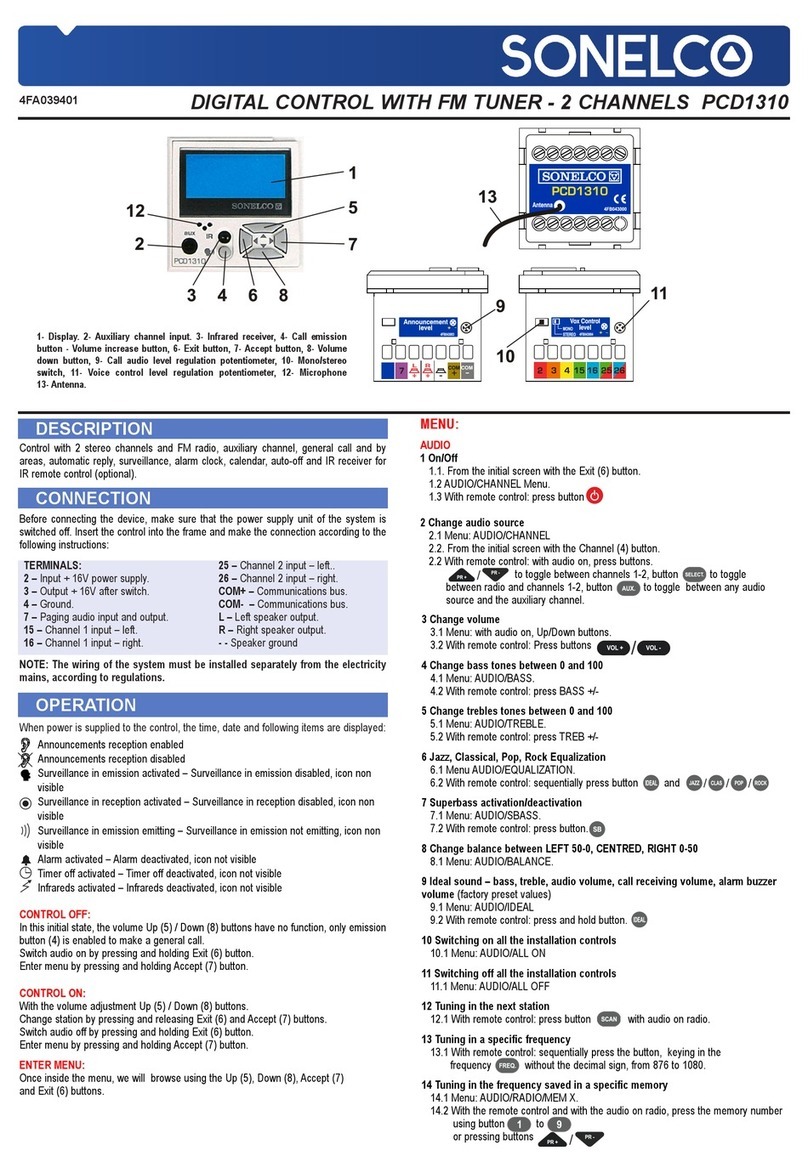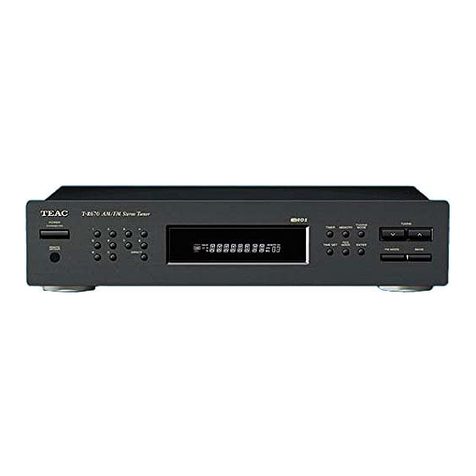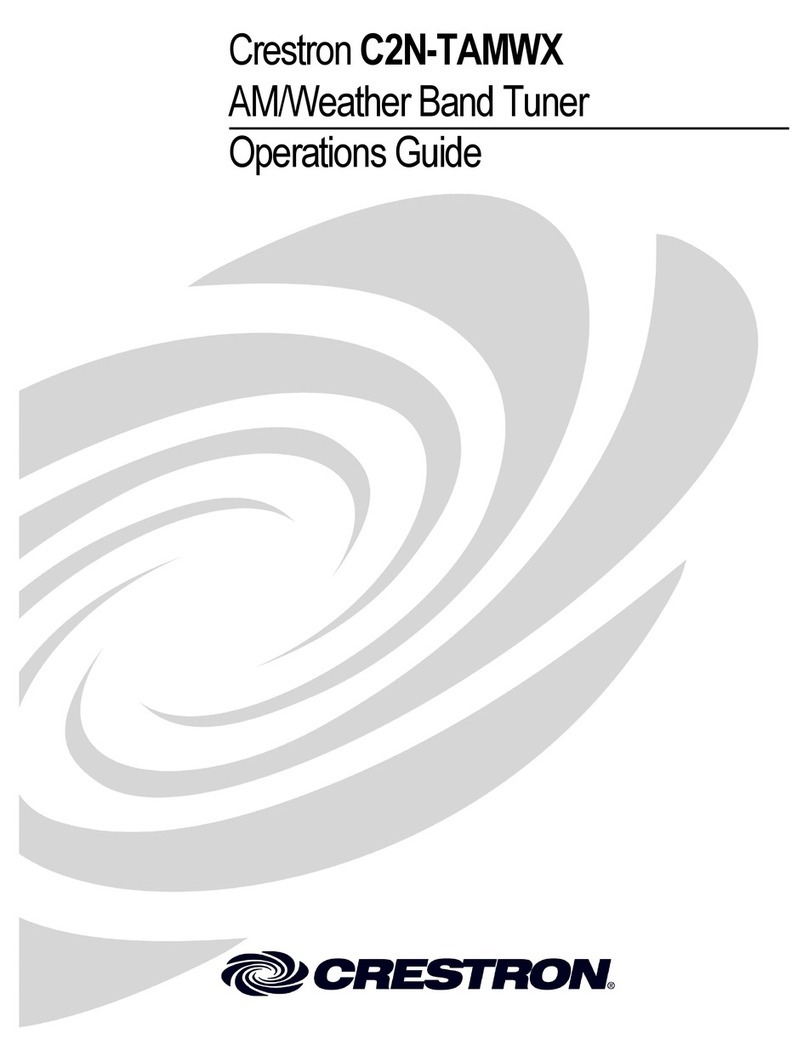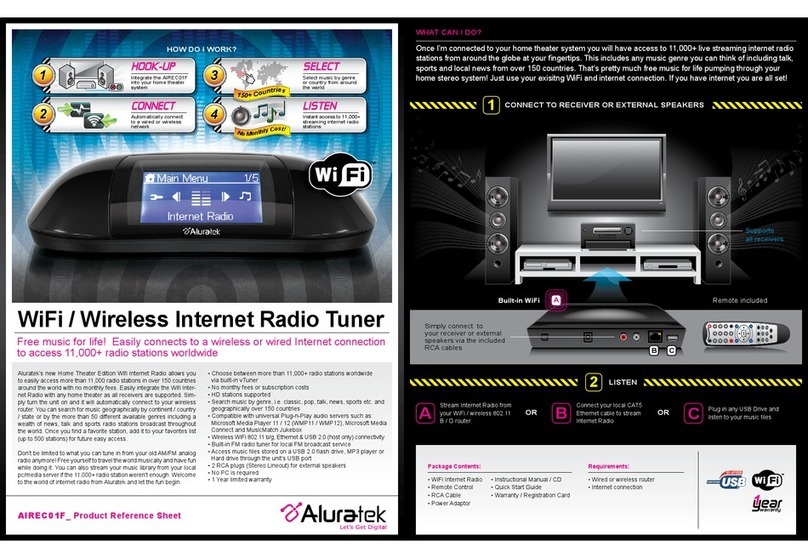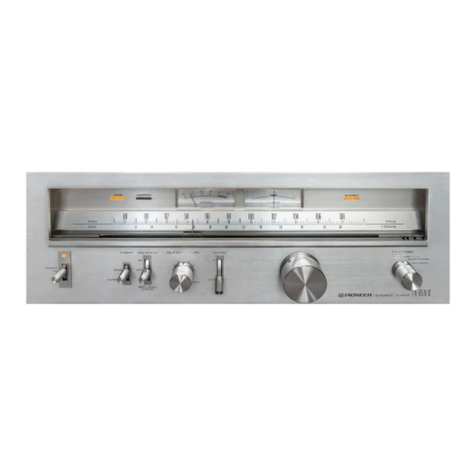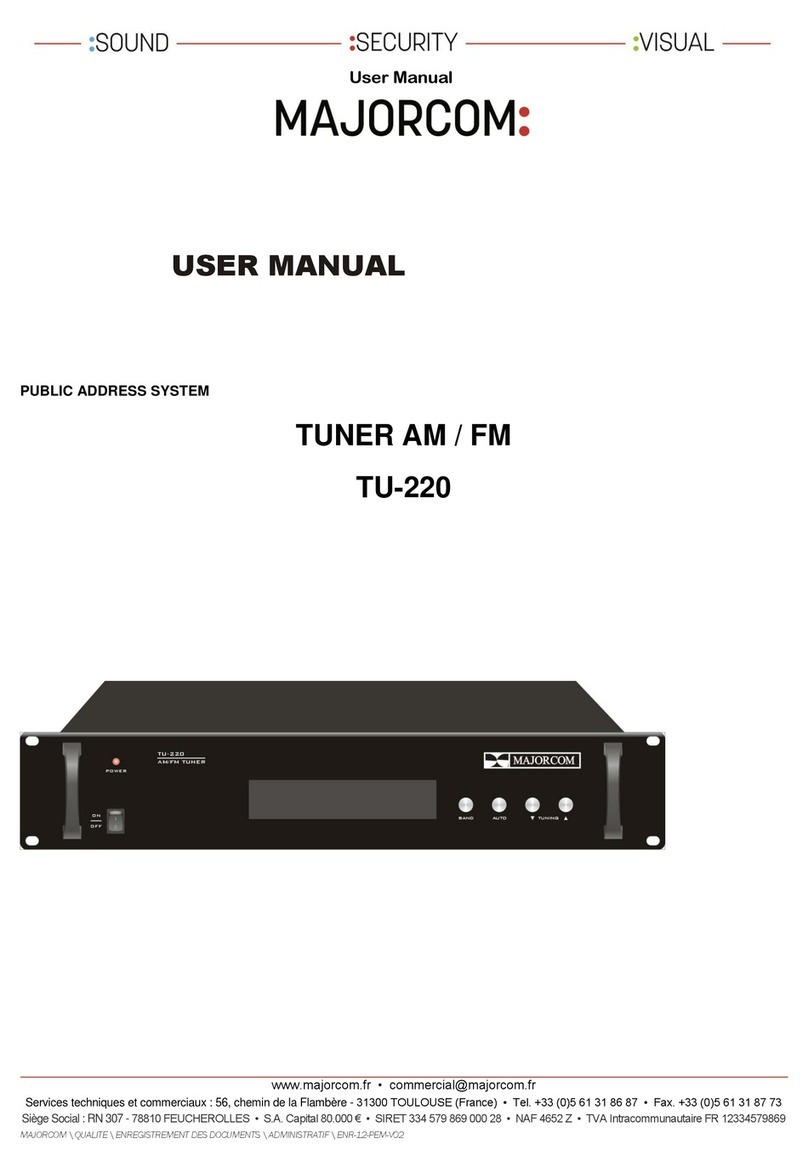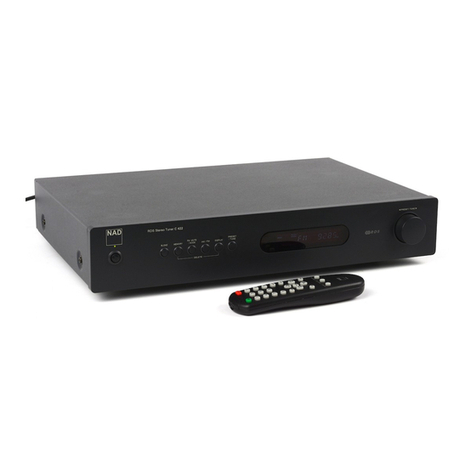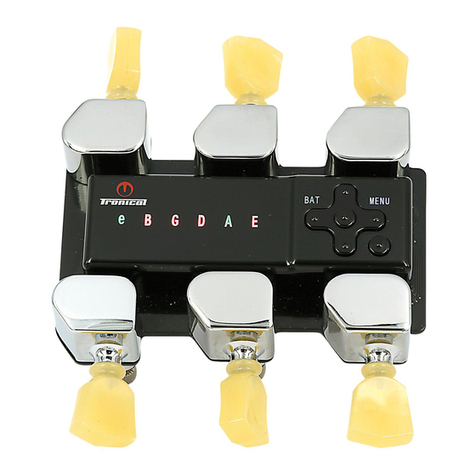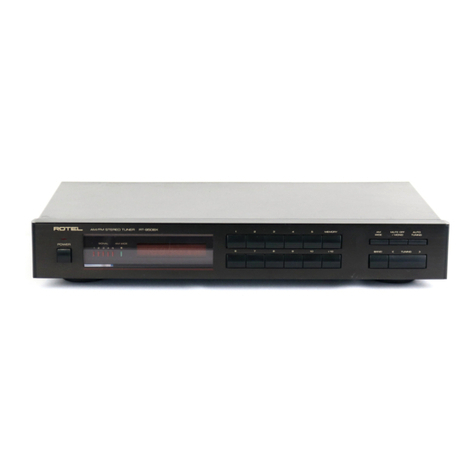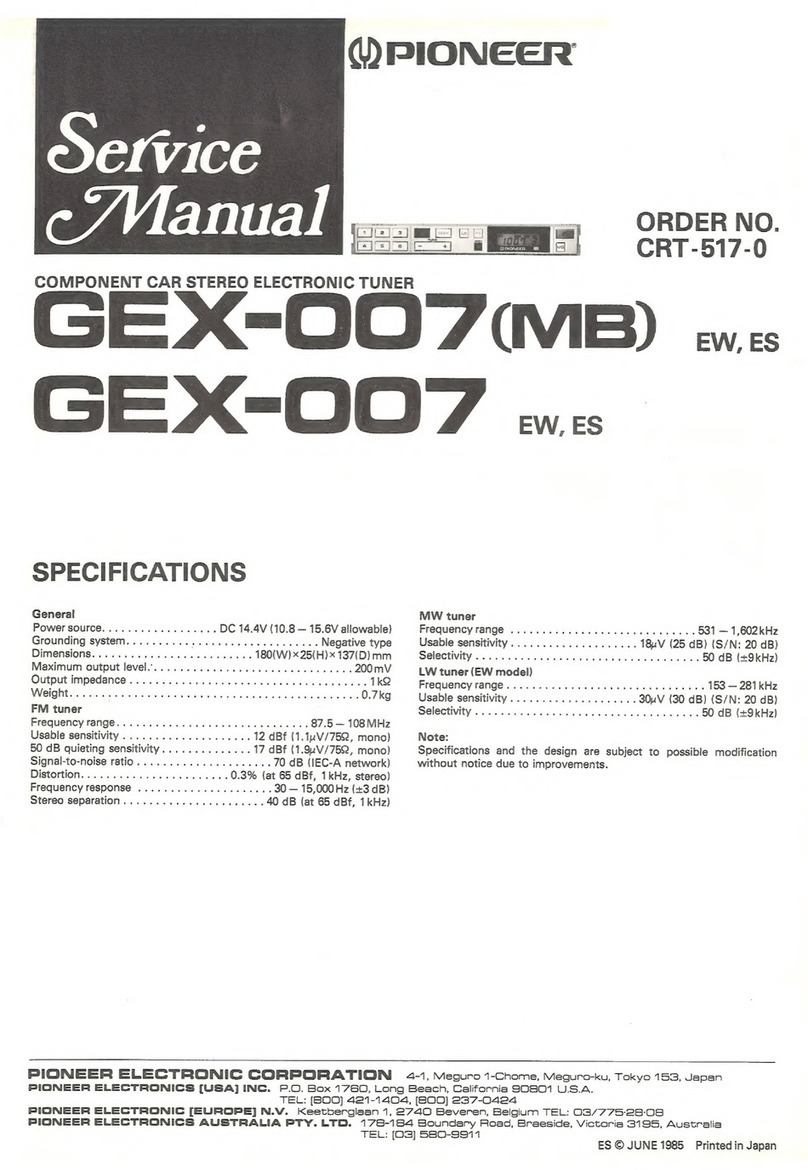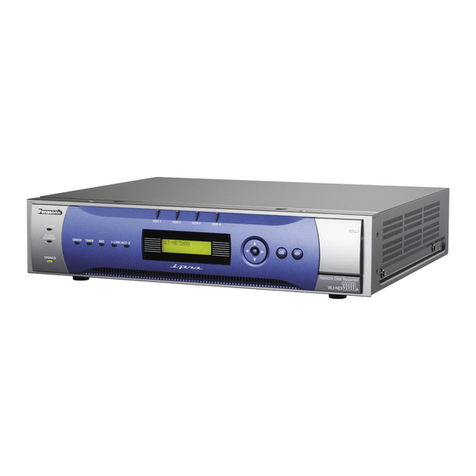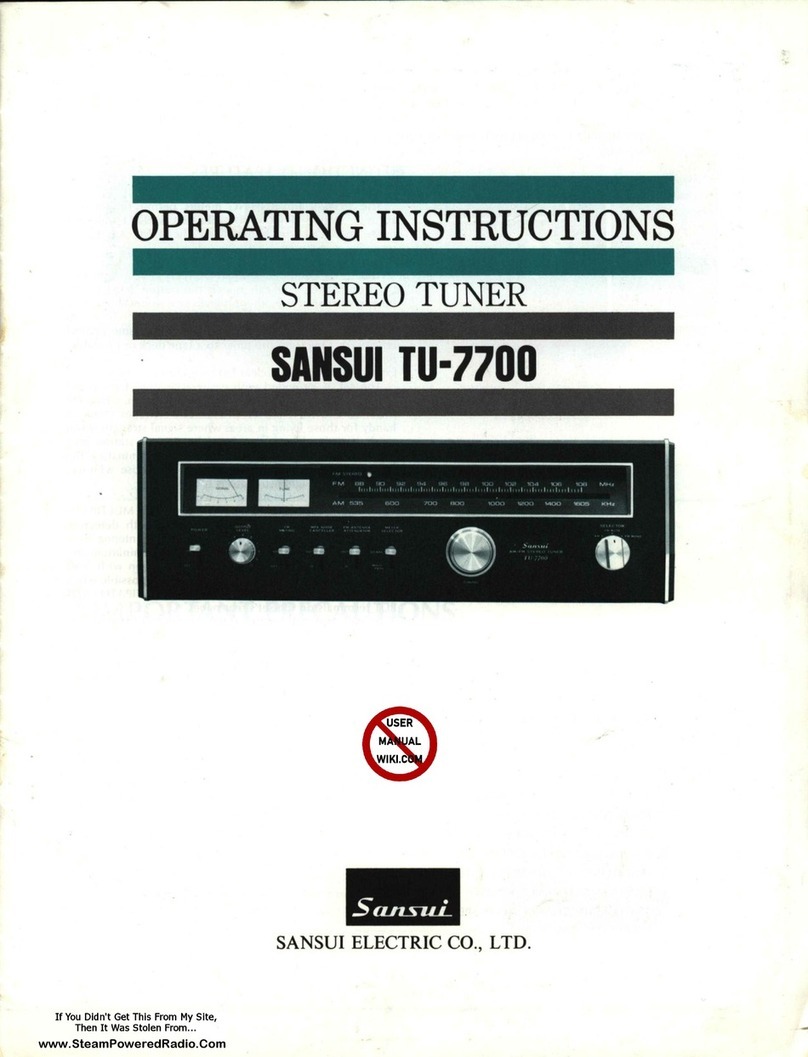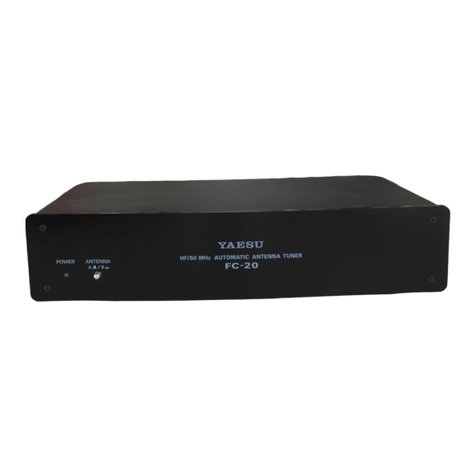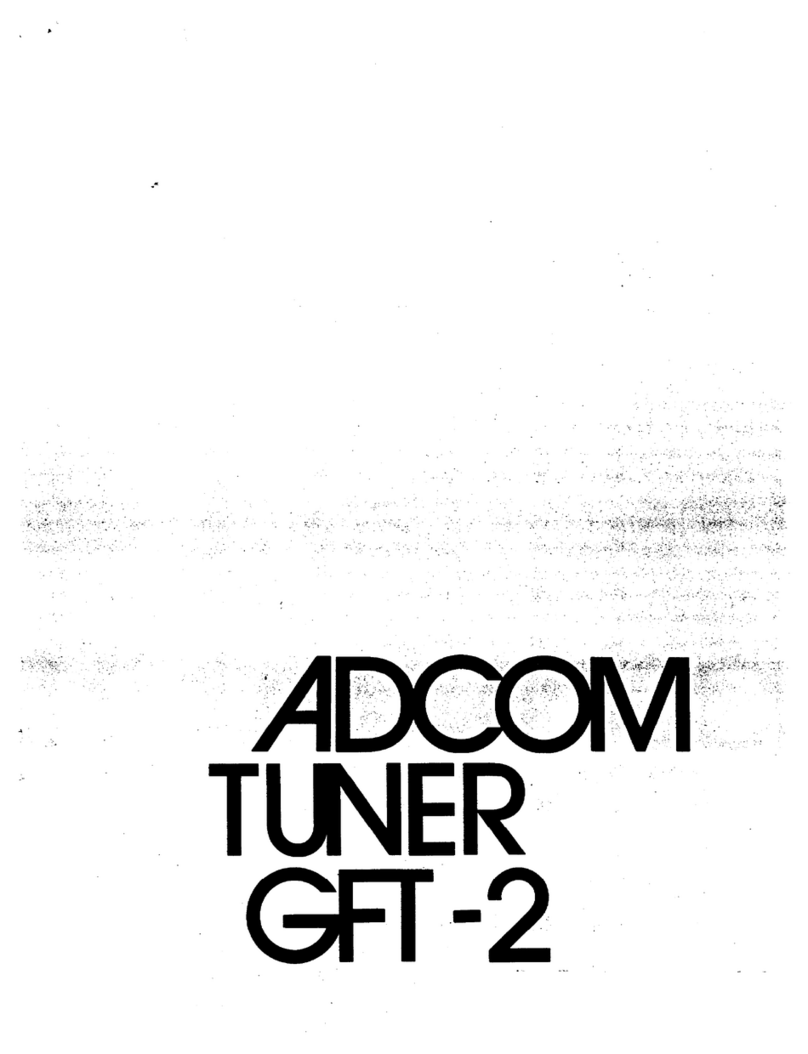Sonelco PCD3666 User manual

DIGITAL FM STEREO PCD3666
MODELS: PCD3666-01 (White) PCD3666-02 (Charcoal grey)
DESCRIPTION
Microprocessor-controlled digital FM Stereo Tuner
Backlit liquid crystal display to view functions
Automatic tuningsearch, using FUZZY LOGIC thanks to which the search process is
extraordinarily quick. Remote scan. “Compact” series size and presentation.
If you wish to connect the tuner to the installation bus connect the 2-way connection into
the module. Connect the White/COM+ and Grey/COM- cable into the installation bus,
taking special care not to make a mistake in the order of the cables. This connection by
Bus will enable you to access certain remote mode functions, from controls that incorpo-
rate this function.
Note: To be able to correctly tune the stations, a good antenna signal is required. The
tuner incorporates two strips (ANT, M) for later connection of the outside antenna for FM.
(cable coming from the RF distribution). The wiring of the system must be mounted sepa-
rately from the electricity supply mains.
The tuner will enter into operation automatically when the system is switched on. After
start-up the display will show an initialisation message for a few seconds and will present
the frequency of the last station that was selected.
Warning: if no keys on the tuner have been used for 75 seconds, the backlighting will dis-
connect and it will show the last frequency tuned in. If we are in any menu option, we will
quit it.
ACCESS TO MENU:
All the functions are controlled with the 4 keys on the front
Menu/clear: Enter into menu mode / Quit mode
OK: Accept the mode that the display presents
Up and Down: It goes up and down the menu options.
To access the functions of the menu press the MENU/CLEAR key.
The SEARCH indication will appear on the display (first menu option).
By pressing UP or DOWN you can go up and down the menu.
The display will show in a sequence the following options of the main menu:
1-SEARCH, 2-LEVELS, 3-MODE, 4-LANGUAGE, 5-AUTO, 6-REMOTE, 7-CHANNEL
Press OK to select the desired option from the main menu.
Once inside an option of the main menu choose one of the secondary options with
UP/DOWN and press OK to enter the mode selected. If you wish to quit the function
selected and return to the previous menu press MENU/CLEAR. There is an auxiliary func-
tion, ERASE MEMORIES, which can be accessed directly.
CONTROL CONFIGURATION:
The control leaves the factory with the following preset configuration:
Type of SEARCH: DIRECT
LEVEL: 15Uv
MODE: STEREO
LANGUAGE: SPANISH
REMOTE: YES (Remote scan enabled)
CHANNEL: CHANNEL 1
If you wish you must change it to adapt it to your need
MENU FUNCTIONS
SEARCH
To tune stations.
It enables us to choose between two types of search:
MEMORY: To search for a previously tuned station and stored in one of the 25
memory possible positions.
DIRECT: To tune a station and memorise it if we wish.
LEVELS
It permits establishing the minimum signal level that the stations, which we wish to auto-
matically tune in, must have. With this mode we will be able to choose between four
levels. When we make the automatic search, the tuner will stop at the stations that recei-
ve a signal of the same or higher level than the level that we have established in the tuner.
It permits 4 levels: Minimum: Level > 15 uV (Start option)
Middle 1 Level > 35 uV
Middle 2 Level > 75 uV
Maximum Level > 300 uV
GENERAL CHARACTERISTICS
- Menu can be selected in Spanish or English.
- 25 permanent storage memories
- Remote scan from any PC/PM control.
- Programmable type of scan (memories/tuning); in the first case, the scan will only
act upon the prerecorded memories.
- Protection against overloads in audio outputs.
- 4 search sensitivity levels, programmable between 15 mV and 300 mV
- Programmable mono/stereo
- Rear connection by screw strip for FM antenna input.
MODE
To select the type of audio signal
Two options: Mono: We must select this mode when our installation is Mono.
Stereo: (Start option). For stereo installations.
LANGUAGES
To select the language of the display messages
It permits 2 languages: Spanish. Start option
English
AUTO.
This mode enables us to automatically search for and memorise the stations in your area.
It will search and store in memory all the stations that it detects until it completes the 25
possible memories.
It is the simplest recommended method to search for stations.
REMOTE.
This menu option enables us to configure the tuner so that we can make a station search
from other controls of the installation (whenever the C+/C+ bus cables or the Scan 01 wire
are connected). It gives 2 options:
Yes: It permits the scan from other Controls (Start option)
No: It does not permit the change in stations from other controls, (it only admits
local scan)
CHANNEL
Option to assign the address of the channel, which the tuner is connected to.
This option is useful if used in installations with PC1307 controls and the C+/C- bus is con-
nected. The PC1307 controls will only carry out the scan on the tuner that is associated
with the channel, which, at that time, is selected on the control.
Channel 1 (Start option)
Channel 2
ERASE MEMORIES
Warning!: It enables us to erase the whole memory programming.
This function is reached directly by keeping the MENU/CLEAR key depressed for at least
3 sec. Options: Total: Erase all the memories
Partial: Erase only the memory chosen.
CONNECTION
OPERATION
Before making the connection make sure that the power supply unit of the installation is
off. Insert the module into the metal base plate and make the connection according to the
following indications:
TERMINALS:
2- Positive – 16 nominal Vdc supply
4- Negative – Power supply and signal ground
05- Left channel audio output
06- Right channel audio output
01- SCAN input
ANT- Antenna (see installation recommendations on page 2)
M- Antenna ground
Communication bus 2-way connector
COM+(White)/COM-(Grey)- To connect to Installation Bus.
1 – DISPLAY
2 – KEYPAD
3 – COMMUNICATION BUS CONNECTION
4 – CONNECTION

PCD3666/29-08-03
1. Selection of the Search level
To select the minimum or threshold signal level of the stations that you wish to search for,
access LEVELS function of the menu.
Press OK to enter the function.
With UP or DOWN select the MINIMUM, MEDIUM1, MEDIUM2, OR MAXIMUM mode.
Press OK and the display will flash indicating the mode chosen.
2. Mode Configuration: Mono/Stereo
Press Menu/Clear.
With UP/DOWN select MODE.
Press OK, to enter the MODE function, and press UP/DOWN to select MONO or STE-
REO. Press OK to accept the option chosen. The display will flash showing the options
chosen.
3. Language selection
Press Menu/Clear.
With UP/DOWN select LANGUAGE.
Press OK to enter the function.
Press UP or DOWN and select the desired language.
Press OK to accept the option chosen.
The display will flash indicating the language chosen.
4. Selection of remote SCAN.
To be able to enable or disenable the change in stations from a control of the system.
Press Menu/Clear.
With UP/DOWN select REMOTE.
Press OK to enter the function.
Press UP or DOWN and select Yes or No.
Press OK to accept the option chosen.
The display will flash showing the option chosen.
Remote SCAN function.
The automatic tuning/memory search is carried out physically through terminals 01 or
COM+, COM1 (for controls with communications bus).
This search can be made in two ways, depending on the mode that we have selected on
the menu.
-A memory scan will advance through the stations recorded on the memories of the
tuner.
-A tuning scan will make an automatic search based on the current frequency in
upward direction.
In addition, if we connect the tuner to modules with communications bus and if
these permit this, we will be able to:
-Make a remote scan through the bus. The tuner will inform the control of the fre-
quency it is on.
-Ask which frequency the tuner is on.
5. Assignment of CHANNEL1/CHANNEL 2
Only when the option with communications bus is installed.
In systems with domotic controls the address of the channel the tuner occupies is asso-
ciated with it, so that when a control has the tuner channel selected, it can carry out remo-
te scan and receive information of the frequency of the station that is tuned in.
Press Menu/Clear.
With UP/DOWN select CHANNEL.
Press OK to enter the function.
Press UP or DOWN and select CHANNEL1 or CHANNEL2.
Press OK, to accept the option chosen.
The display will flash showing the option chosen.
TO SEARCH FOR STATIONS:
1. Automatic search for stations
The simplest procedure to search for stations in the area and memorise them is to use the
Automatic search method.
-Press MENU/CLEAR to access the menu
-Press UP or DOWN until AUTO appears on the display
Press OK to select this mode.
The tuner will start an automatic exploration of the whole FM band and will store them in
its memory in a sequential fashion up to a maximum of 25 memories.
2. Direct search. Memorise stations (manual)
Direct Search
Press MENU/CLEAR to access the SEARCH function of the menu.
Press OK to enter the function.
Press UP or DOWN until the display shows DIRECT and press OK to select the option.
The display will flash and will show the option chosen.
Press UP/DOWN. One brief touch will change 50 Khz. A longer touch will make the tuner
automatically search for the next or previous station.
MEMORISE STATIONS
After selecting the desired station to memorise it press OK.
The display will show: SAVE and then the number of the memory MXX. With the UP or
DOWN key select the memory number where you wish to save the station. If the display
indicates MXX LIBR, the memory is free.
If it indicates MXX the memory is occupied.
Press OK to save. The display will flash several times to indicate that the station has been
memorised and it will indicate the frequency again.
The tuner has 25 memories.
3. Search for memorised stations
This model enables you to explore the stations that have been previously memorised by
any of the previous methods.
With the keypad select the SEARCH – MEMORY mode.
Press UP/DOWN to go to the next/previous memory position that has a station stored,
skipping the ones that are free.
4. Delete memories
To access the delete function press CLEAR, until the display shows:
DELETE?
Press OK, and it will enter the delete options.
With UP/DOWN select the desired TOTAL or PARTIAL option.
TOTAL: Press OK to accept this option. The display will show the message, DELE-
TING MEMORIES and then WAIT flashing on and off as long as the deleting lasts (seve-
ral seconds).
TECHNICAL CHARACTERISTICS
NSTALLATION EXAMPLES:
INSTALLATION RECOMMENDATIONS
PARTIAL:Press OK to accept this option. MXX will appear.
Press UP/DOWN to select the memory we wish to delete from those that are already sto-
red. At the same time we will hear its sound.
Once selected, press OK and we will delete the station from the memory.
This option will be repeated until we press MENU/CLEAR or until 12 seconds have elap-
sed since we have stopped operating the tuner.
NOTE: The tuner maintains its configuration, as well as the last tuning selected, although
power is cut off from the main unit.
Power supply voltage (nominal): 16 VDC
Consumption on standby status (maximum). 56 mA
Consumption on ON status (maximum): 74 mA
Audio output level: Between 1.5 and 2 Vms (Depending on the station)
Antenna connector input: 75 ohm
Reception frequency: 87.50 MHz – 108.00 MHz
Input sensitivity: 3.5 mV
Programmable search sensitivity: 15 mV(minimum), 35 mV(medium1), 75 mV (medium2)
and 300 mV (maximum)
Signal/noise ratio: 68 dB (MONO) / 63dB (STEREO)
Maximum harmonic distortion: 3%
Several types of installations can be carried out with the PCD3666 tuner:
1- Connection as centralised sound source: In this first case, the PCD3666 tuner sup-
plies 1 music channel to the whole system. The simplest installation would be in combi-
nation with a power supply source P3262 (diagram 1). Another possibility would consist
in using a main unit P3221 or P3261 with 1 musical channel, which an outside sound sour-
ce would be connected to (compact-disc, radiocassette, etc.); in this case the system will
have 2 channels.
2- Connection as local sound source: This type of connection provides an exclusive
tuner for one single zone (see diagram 2), thus having an additional background music
channel to those distributed throughout the whole home.
ANTENNA: If there is no 75-ohm antenna signal available in the installation, a 75 cm long
cable can be used as antenna.
In any case, both the tuner and the antenna must be located as far away as possible from
the electricity supply mains cables as well as from any source of electromagnetic interfe-
rences (household appliances, motors, fluorescent lights, halide lights, etc.)
Do not place this product in damp atmospheres, close to heat sources or in potentially
explosive atmospheres.
The connection to the electricity supply mains, installation, cable section and wire laying
will be carried out according to the specific directives and standards of each country.
Sonelco declines any responsibility that might be derived from the improper use of
the product or installation that does not comply with the recommendations.
These characteristics are only given as reference. The manufacturer reserves the right to introduce any amendments without prior notice in order to improve the product.
Diagram 1
Diagram 2
This manual suits for next models
2
Other Sonelco Tuner manuals

